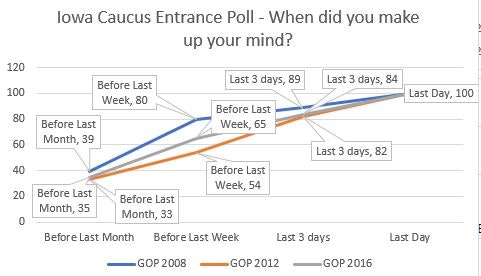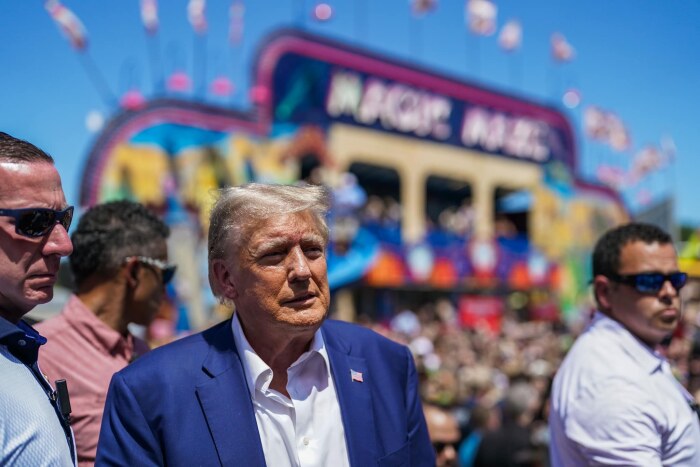Dan Guild is a lawyer and project manager who lives in New Hampshire. In addition to writing for Bleeding Heartland, he has written for CNN and Sabato’s Crystal Ball, most recently here. He also contributed to the Washington Post’s 2020 primary simulations. Follow him on Twitter @dcg1114.
The gold standard Iowa pollster, Selzer & Co—their caucus record is nothing short of amazing—is out with a new poll showing former President Donald Trump with a significant lead among likely Republican caucus-goers. He has 42 percent support, Florida Governor Ron DeSantis has 19 percent, and Senator Tim Scott has 9 percent. Former Vice President Mike Pence and former United Nations Ambassador Nikki Haley were tied at 6 percent, former New Jersey Governor Chris Christie registered 5 percent, entrepreneur Vivek Ramaswamy 4 percent, and all others at 2 percent or less.
I have written about the Iowa caucuses and their history many times. A few reminders:
First, there is no national primary. Often Iowa polling diverges from national polling for a simple reason: the campaign is fully engaged in Iowa in a way it is not nationally.
Second, front-runners beware. As I have written before, there is often significant movement in Iowa in the last ten days. In Republican caucuses, that late shift has allowed several candidates who appealed to social conservatives to do far better than expected (Rick Santorum, Pat Robertson, Pat Buchanan, Mike Huckabee).
Third, as Iowa goes, New Hampshire does not. The Iowa caucuses and the New Hampshire primary have very different electorates. While 63 percent of Iowa Republican caucus-goers are evangelicals, only 25 percent of New Hampshire GOP primary voters are. No GOP candidate since 1980 has won both Iowa and New Hampshire.
Let’s start by comparing Selzer’s Iowa Poll for the Des Moines Register, NBC News, and Mediacom to recent national polling of Republicans. Some other polls are available, but one of the lessons of 2022 was to stick to the better pollsters.

Here are the key takeaways from the Iowa and national numbers:
1. Trump’s lead in Iowa (23 points over his closest rival) is smaller than it is nationally. Moreover, there is no evidence Trump’s recent indictments have had much impact on Iowa. On the contrary: the Selzer poll found,
In the days before the indictment, Trump led DeSantis 38% to 20%. In the days after, his lead grew to 43% over DeSantis’ 18%.
Trump’s Iowa footprint, combining his first-choice support, second choice and those actively considering him, also increased 12 percentage points after the Georgia indictment was announced — from 55% to 67%.
2. In some national polling, Ramaswamy has been close or even tied DeSantis for second. However, he shows no similar surge in Iowa. (State Treasurer Roby Smith endorsed Ramaswamy on August 21, hours after the Selzer poll’s release.)
3. Conversely, DeSantis has seen a significant deterioration in his national numbers. That does not appear to be the case in Iowa, where dozens of current and former state legislators have endorsed him, and his super-PAC has lined up campaign chairs in all 99 counties.
4. The candidate in Iowa to watch in Scott, who runs about 7 percent better in Iowa than he does nationally. Moreover, his net favorable rating (59 percent favorable, 17 percent unfavorable, 24 percent unsure) is the highest of any candidate in the new Selzer poll. Another point worth noting: Trump’s unfavorable rating in the Selzer poll (21 percent among Republicans who plan to caucus, 53 percent among independents who plan to attend a GOP caucus) is surprisingly high.
One of the best pieces of data at this point in the cycle is about whether voters have decided who they will support. In some recent polling, those who said they were decided was very high when viewed from a historical perspective. In Emerson’s recent national poll, for example, more than 60 percent of respondents (including more than 80 percent of Trump supporters) said “they will definitely vote for the candidate they selected.”
The Selzer poll finds results far more consistent with other cycles. Selzer found 40 percent had made up their minds. As the chart below shows, usually less than 40 percent of Iowa caucus-goers decide on their candidate before the last month.

Let’s look at the current numbers in a historical context. This chart has a ton of information and may be tough to read. But here are the key points:
Trump currently has the largest lead in Iowa of any prior candidate at this point in the cycle. One reason is the second place candidate, DeSantis, is one of the weakest challengers since 1980. On average the second-place candidate garners 23.7 percent, higher than DeSantis’s 18 percent. The sheer size of the current GOP field gives Trump a significant advantage as well.
Since 1980, seven presidential candidates have been over 40 percent at this point in the cycle. Of those seven, five have gone on to win the nomination, but two of those five were nearly beaten (Bob Dole in 1996, Hillary Clinton in 2016).

Given this history, it is important to look at the cross-tabs to see where Trump might be weak. The following table looks at key groups in Iowa. Given his history, it is certainly surprising to see that Trump does better among evangelicals than he does among the rest of the Iowa electorate.

Trump’s weakness is among the college-educated, who are also less likely to describe themselves as evangelical. This makes Trump an unusual GOP front-runner. To my mind, it also suggests DeSantis has misread the electorate. If Trump is beaten it will likely be because of weakness among college-educated voters, and that is more likely to happen in New Hampshire, where evangelicals are a far less influential voting bloc.
Top photo of Trump at the Iowa State Fair on August 12 was originally posted on the Trump campaign’s Facebook page.

